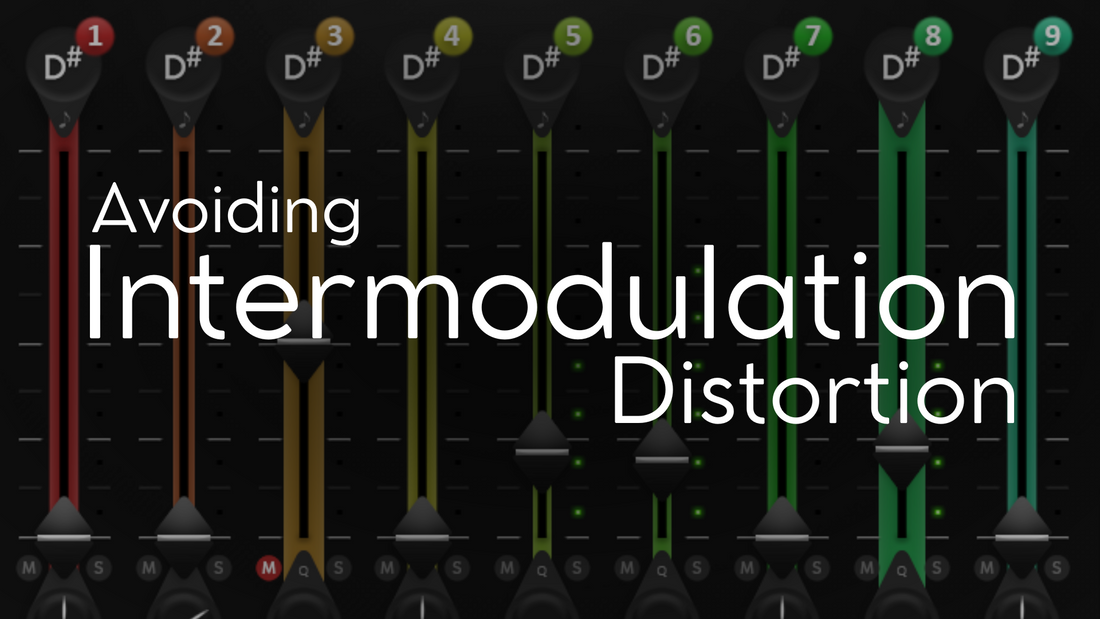When it comes to audio processing, distortion is often used as a creative tool to enhance the character of a sound. However, not all distortion is created equal. One of the most significant issues that can arise during the distortion process is intermodulation distortion (IMD). In this blog, we’ll explore what intermodulation distortion is, how it affects audio quality, and how CARP Audio’s Resonote plugin turns it into something useful to deliver musical and interesting sound characteristics.

What Is Intermodulation Distortion?
Intermodulation distortion occurs when two or more signals interact during processing, leading to the creation of additional frequencies that are not present in the original signal. This phenomenon is particularly common in non-linear audio processing, such as distortion, compression, and saturation.
IMD can manifest as a "muddy" or "harsh" quality, particularly when it involves higher-order harmonics, such as 3rd-order harmonics. These unwanted frequencies can interfere with the clarity and definition of the original sound, making it difficult to achieve a desired tonal balance.
How Does Intermodulation Distortion Affect Your Sound?
The effects of intermodulation distortion can vary depending on the context in which it occurs. Here are a few ways IMD can impact audio quality:
- Loss of Clarity: When IMD is present, it can muddy the sound, making it difficult to distinguish individual elements within a mix. This is particularly problematic in dense arrangements, where clarity is essential.
- Unpleasant Artifacts: IMD can introduce unwanted frequencies that clash with the original sound. This can lead to a harsh or dissonant quality, especially when processing musical notes that are not harmonically related.
- Unpredictable Harmonics: While some harmonics can add warmth and character, unwanted harmonics produced by IMD can detract from the overall musicality of the sound.
How Resonote Addresses Intermodulation Distortion
Resonote is designed to avoid the negative effects of intermodulation distortion by ensuring that only the same note is processed through distortion. This innovative approach takes advantage of Intermodulation Distortion, by only distorting multiples of the same frequency.
Here’s how Resonote achieves this:
- Selective Processing: By focusing on the same note, Resonote avoids the introduction of unrelated frequencies that contribute to intermodulation distortion. This means you get a more defined sound without the muddiness that can arise from overlapping notes.
- Reduced Harmonic Clutter: With fewer 3rd-order harmonics generated during distortion, the resulting distorted resonances in parallel maintain clarity and definition. This allows for greater control over the sonic character, making it easier to achieve unique and heavy characteristics.
- Interesting Sound Characteristics: Rather than just distorting the main signal, Resonote distorts isolated frequencies in parallel. The selective processing creates unique tonal characteristics that can add depth and interest to your audio, making it an excellent tool for sound designers and music producers alike.
- User-Friendly Interface: Resonote’s intuitive design allows users to easily adjust parameters and explore the sonic possibilities. Whether you’re looking to add warmth to a vocal track or create intricate textures in your music, Resonote gives you the control you need to achieve your desired results.
Why Choose Resonote for Your Audio Processing Needs?
By effectively reducing intermodulation distortion, Resonote stands out as a powerful tool for any audio professional. Here are a few reasons why you should consider adding it to your plugin arsenal:
- Enhanced Clarity: Achieve cleaner mixes with less muddiness, using the 'Tame Resonances' feature. It reduces the resonances while leaving the created distortion-harmonics intact.
- Creative Flexibility: Explore new sound textures and characteristics without the worry of unwanted artifacts.
- Optimized for Performance: Designed for efficiency, Resonote allows for real-time processing without compromising sound quality.
Conclusion
Intermodulation distortion can pose significant challenges when processing audio, but with tools like Resonote from CARP Audio, you can use it to your advantage. By ensuring that only the same note is pushed through distortion, Resonote effectively minimizes unwanted harmonics while enhancing the sonic character of your audio with root-related intermodulation distortion.
Whether you're a music producer, sound designer, or audio engineer, Resonote offers a unique approach to distortion that brings out the best in your sound.



